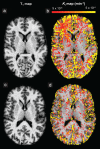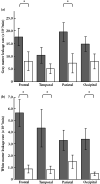Blood-brain barrier leakage years after pre-eclampsia: dynamic contrast-enhanced 7-Tesla MRI study
- PMID: 35502137
- PMCID: PMC9826493
- DOI: 10.1002/uog.24930
Blood-brain barrier leakage years after pre-eclampsia: dynamic contrast-enhanced 7-Tesla MRI study
Abstract
Objective: Pre-eclampsia is a hypertensive complication of pregnancy that is associated with an increased risk of long-term cardiovascular and cerebrovascular disorders. Although the underlying mechanism of persistent susceptibility to cerebral complications after pre-eclampsia remains largely unclear, impaired blood-brain barrier (BBB) integrity has been suggested to precede several cerebrovascular diseases. In this study, we aimed to investigate the integrity of the BBB years after pre-eclampsia.
Methods: This was an observational study of premenopausal formerly pre-eclamptic women and controls with a history of normotensive pregnancy who underwent cerebral magnetic resonance imaging (MRI) at ultra-high field (7 Tesla) to assess the integrity of the BBB. Permeability of the BBB was determined by assessing leakage rate and fractional leakage volume of the contrast agent gadobutrol using dynamic contrast-enhanced MRI. BBB leakage measures were determined for the whole brain and lobar white and gray matter. Multivariable analyses were performed, and odds ratios were calculated to compare women with and those without a history of pre-eclampsia, adjusting for potential confounding effects of age, hypertension status at MRI and Fazekas score.
Results: Twenty-two formerly pre-eclamptic women (mean age, 37.8 ± 5.4 years) and 13 control women with a history of normotensive pregnancy (mean age, 40.8 ± 5.5 years) were included in the study. The time since the index pregnancy was 6.6 ± 3.2 years in the pre-eclamptic group and 9.0 ± 3.7 years in controls. The leakage rate and fractional leakage volume were significantly higher in formerly pre-eclamptic women than in controls in the global white (P = 0.001) and gray (P = 0.02) matter. Regionally, the frontal (P = 0.04) and parietal (P = 0.009) cortical gray matter, and the frontal (P = 0.001), temporal (P < 0.05) and occipital (P = 0.007) white matter showed higher leakage rates in formerly pre-eclamptic women. The odds of a high leakage rate after pre-eclampsia were generally higher in white-matter regions than in gray-matter regions.
Conclusion: This observational study demonstrates global impairment of the BBB years after a pre-eclamptic pregnancy, which could be an early marker of long-term cerebrovascular disorders. © 2022 The Authors. Ultrasound in Obstetrics & Gynecology published by John Wiley & Sons Ltd on behalf of International Society of Ultrasound in Obstetrics and Gynecology.
Keywords: 7 Tesla; blood-brain barrier; cerebrovascular disorder; dynamic contrast-enhanced MRI; pre-eclampsia.
© 2022 The Authors. Ultrasound in Obstetrics & Gynecology published by John Wiley & Sons Ltd on behalf of International Society of Ultrasound in Obstetrics and Gynecology.
Figures



 ) and in controls with a history of normotensive pregnancy (
) and in controls with a history of normotensive pregnancy ( ). Error bars indicate SD. *Regions with a significantly different leakage rate between groups.
). Error bars indicate SD. *Regions with a significantly different leakage rate between groups.References
Publication types
MeSH terms
Substances
LinkOut - more resources
Full Text Sources
Medical

